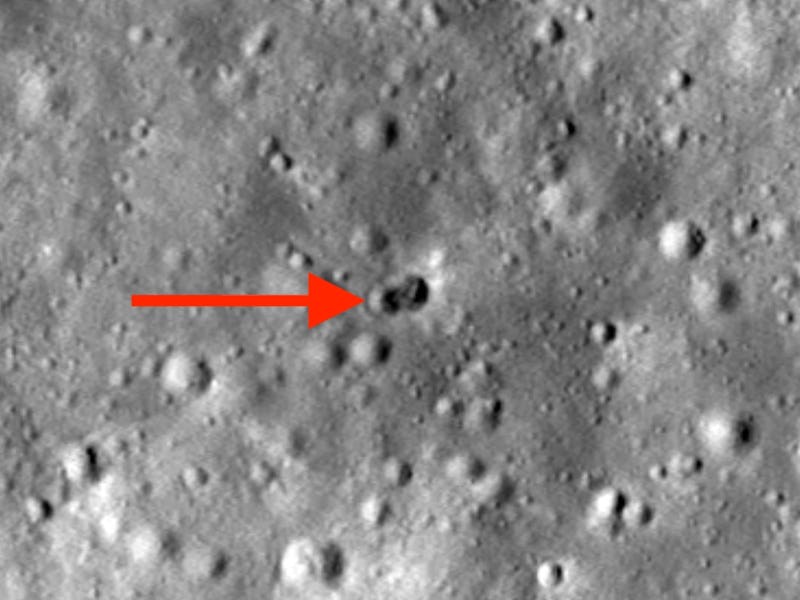NASA discovery could reveal whose rocket booster crashed into the Moon in March
The crater could help identify the (probably Chinese) rocket.

There’s a new crater on the Moon. NASA’s Lunar Reconnaissance Orbiter recently spotted a crater left by the stray rocket booster that crashed into the far side of the Moon in March. And the shape and size of the crater may help finally identify the unknown — but probably Chinese, based on trajectory estimates and other observations — rocket.
What’s New – The crater appears in recently-released photos from May 21, when LRO flew over the rough, rock-strewn landscape between two enormous ancient asteroid impact craters: Mare Orientale and Hertzsprung Crater.
Those photos show a fresh crater where there wasn’t a crater before; it’s notably absent in images from LRO’s last pass over that part of the Moon, on February 28. In other words, the crater must be new, and the impact that formed it must have happened sometime between February 28 and May 21. The timing, and the location, line up well with the crash of an empty rocket booster on the far side of the Moon early on the morning of March 4. Astronomers tracking the booster’s trajectory had predicted that it would crash somewhere near Hertzsprung crater, and the LRO team had been keeping an eye out for its impact crater since then.
Now, it looks like they’ve found it. But the booster’s impact crater isn’t quite what anyone expected. It’s actually two craters: one about 16 meters wide, and a second one, about 18 meters wide, on top of the first and a bit to the east. The surprising double crater may offer some clues about which rocket booster crashed into the Moon and where it came from.
“Since the origin of the rocket body remains uncertain, the double nature of the crater may indicate its identity,” said NASA in a statement.
This May 21 LRO photo shows the double crater on the far side of the Moon.
Here’s the Background – The unknown rocket booster first made headlines in January, when Bill Gray (author of the near-Earth object-tracking blog Project Pluto) realized that it was on a collision course with the Moon. We’ve crashed plenty of rocket boosters on the Moon since the 1970s, but this is the first human-made object that’s crashed there accidentally and without at least a general destination in mind.
In January, some quick calculations of the booster’s orbit suggested that it might be the second stage of the SpaceX Falcon 9 rocket that had carried NASA’s Deep Space Climate Observatory, or DISCOVR, to lunar orbit in 2015. But by February, new information about DISCOVR’s trajectory, along with updated calculations, pointed the finger instead at China’s space agency. The most likely culprit seemed to be a third-stage booster from the rocket that launched China’s Chang’e 5-T1 spacecraft in 2014 (Chang’e 5-T1 was a precursor to the Chang’e 5 lunar sample return mission, launched in 2020).
A group of astronomy students at the University of Arizona measured the spectrum of light reflected from the booster’s paint and said it that of matched other, similar Chinese rocket boosters. But China’s foreign ministry denied the allegations, arguing that the booster had fallen back into Earth’s atmosphere and burned up during re-entry.
Shortly after that, U.S. Space Command announced that the Chang’e 5-T1 booster didn’t re-enter Earth’s atmosphere, but added that it couldn’t confirm either the status of the Chang’e 5-T1 booster or the identity of the booster headed toward the Moon.
What’s Next – Now that LRO has found the crater, its size and shape could offer more evidence to help identify the crashed booster.
According to NASA, the double crater suggests that whatever hit the lunar surface may have had large masses at both ends. If that’s correct, then the heavy ends would have impacted a few seconds apart, digging two adjacent craters.
A rocket is essentially a big fuel tank with an engine at one end, which means a spent booster is essentially an empty tube with a heavy engine at one end – and no large mass at the other end. That’s why rockets that crash into the Moon usually leave single, irregularly-shaped craters. Compare the mystery booster’s double-crater with the craters from the Apollo 13, 14, 15, and 17 third-stage rockets below.
These photos from NASA’s Lunar Reconnaissance Orbiter show the impact craters from the second-stage rockets that boosted the Apollo 14, 15, and 17 spacecraft out of Earth orbit and toward the Moon. Once empty, the rockets were jettisoned and crashed into the Moon as seismic experiments.
At the end of the day, identifying the ill-fated booster is mostly a matter of curiosity. The responsible party, whether it’s a private company or a national space agency, might be mildly-to-moderately embarrassed by the high-profile crash, but there are no legal consequences for lunar littering.
Why It Matters – March’s incident was the first time a piece of space junk has accidentally landed on the Moon, but given the constantly-growing cloud of space debris around our planet, it probably won’t be the last.
At the moment, the Moon has no ecosystems or infrastructure to be damaged by crashing space debris. It does, however, hold some of humanity’s most important historic sites. It was pure luck that the unknown rocket booster landed on the far side of the Moon, and not smack in the middle of Tranquility Base.
Errant space junk is also the kind of problem that could eventually impact (not sorry) future lunar outposts.
“If we want to establish a permanent presence on the Moon, we should start caring about how we dispose of rockets and spacecraft and satellites,” said Australian National University astronomer and space environmentalist Doris Grosse in a statement at the time of the crash. “We should not be intentionally or unintentionally using the Moon as a space cemetery.”
This article was originally published on